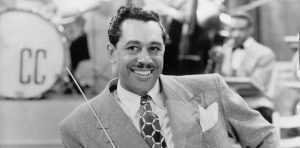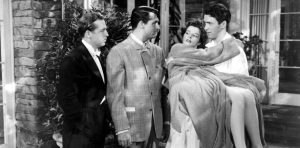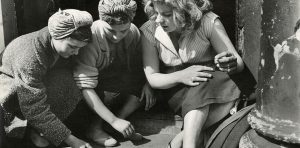
Getting to the point
The fourth of my articles for clothing brand House of Foxy’s menswear line 20th Century Chap, published in March 2017.
Kitty stepped out of the front door of her lodgings on the morning of the 27th June 1944, completely oblivious to the fact that today was the day her life would change forever. Today was the day she was going to die.
She’d come to England in 1938 as a girl of sixteen when her dad, whose work as an aviation engineer, had brought him to the attention of the Vickers-Armstrong company. Her, her dad and her mother had swiftly moved ‘across the pond’ from America to work in the company’s new headquarters at Brooklands in Surrey. Being a bright and likable young woman Kitty soon found employment as a secretarial assistant in the records department. The people were nice enough, but she wasn’t particularly challenged and longed to take more of an active role in aviation. She wanted to fly aeroplanes like her hero Amelia Earhart. When Britain declared war on Germany in October 1939 she thought her chance might come. In March 1940, on the day of her 18th birthday, she hopped on a bus into Weybridge and volunteered for the Women’s Auxiliary Air Force hoping this might give her an opportunity to pursue her dream.
A few weeks later she was shipped to RAF West Drayton for basic training. She aced every test and every physical challenge and was soon assigned to Fighter Command stationed at RAF Biggin Hill and moving swiftly up through the ranks. In a few short months she had earned the rank of Section Officer and started training on the maintenance and armament of fighter aircraft. It was about at this point that she learned her first piece of bad news; she would never be allowed to actually fly aircraft. All military pilots were men, the only female pilots were those who had previous commercial experience of flying and were attached to the non-military Air Transport Auxiliary. Even then they were only permitted to fly transport runs or ferry aircraft from base to base, strictly non-combat. This was a massive shock to Kitty, but a worse shock was to come a few months later, on September the 4th at 13:00 hours, when a group of German bombers dropped their payload on the factory at Brooklands. Both her mother and father were at work that day and were killed instantly in the bombing run. Kitty was now an orphan, one of so many during the war.
The death of her parents was a devastating blow and Kitty grieved for quite some time. When she returned to her work at the W.A.A.F she was more serious, more determined, more driven. She quickly came to the attention of a recruiter for the Special Operations Executive, a secret government initiative whose purpose was to set up and conduct espionage, sabotage and intelligence gathering reconnaissance missions into German occupied Europe. This transfer prompted her move from RAF Biggin Hill to Baker Street in central London and onward to various training camps at secret locations in Hampshire, Cheshire and the wilds of Scotland. After eighteen months of intense training she was “passed out” as a field agent. During this time the war in Europe had become more desperate and she was immediately cleared for active duty. Her command of the French language and knowledge of the French capital of Paris led to her being parachuted into the city on 14th February 1943 under the code-name “Valentine”.
What she did in France for the next year is a story for another time, although she did happen to return to England on a few occasions to recuperate from missions. One such occasion was in June 1944, which brings us back once again to the morning of the 27th.
Kitty had decided to walk down the Holloway road into Islington that morning and grab a late breakfast and some coffee before heading to H.Q. for her afternoon briefing. She’d been out dancing the night before with some fellow Baker Street Irregulars – the nickname SEO agents gave themselves – and had slept in a little later than usual as a treat. By 12:30 hours she was making her way back towards Highbury & Islington station through the Compton Terrace Garden when she heard the tell-tale sounds of aircraft overhead. Looking up she spotted a group of Spitfires out on patrol. As she neared Highbury Corner she heard another engine, but this one was different, a new sound she hadn’t heard before, a much deeper throaty rattling, unlike that of a propeller engine. She became aware of other people in the street stopping to look up at the sky to see where this noise was coming from. High up she could just make out the wingspan of something small, but couldn’t recognise the shape. Just when she couldn’t imagine the sound becoming any loader it stopped. There was a moment of pure silence. Then the shape started to get rapidly bigger and she recognised it as one of the new German V1 ‘doodlebug’ bombs. An air raid siren started howling, too late to make a difference. People around her were shouting and screaming. She broke into a sprint, hoping to find some shelter, some protection from the blast she knew was about to happen. She’d barely made it 10 feet before the bomb impacted in the street behind her and everything went black and silent.
TO READ MORE GO TO:
https://amzn.eu/d/bwUzCgs

The fourth of my articles for clothing brand House of Foxy’s menswear line 20th Century Chap, published in March 2017.

The third of my articles for clothing brand House of Foxy’s menswear line 20th Century Chap published in February 2017.

During In Retrospect Magazine‘s brief run I occasionally got the opportunity to write a review or two and, as I

For my In Retrospect Issue 07 lead article I contemplate the social classes of the original owners of vintage clothing